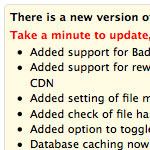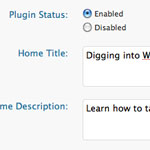Posts categorized: Plugins

WordPress CMS Plugins
To make room for new content for the DigWP 3.3 update, we’re “excerpting” this section into its own blog post. Here you’ll find an extensive round-up of CMS plugins for WordPress. This includes CMS plugins for better admin functionality, user-role management, custom content display, e-commerce and shopping carts, forums, newsletters, and a whole lot more. This isn’t a comprehensive list, so be sure to let us know of any awesome CMS plugins that we might have missed.

Plugins for SOPA/PIPA Blackout
The Stop Online Piracy Act and the Protect IP Act will make things worse online by imposing unnecessary regulation over the Web. To protest these two horrible bills, major websites (including Google and Wikipedia) will “blackout” their content on Wednesday, January 18, 2012. We’re joining in too, and will be shutting down DigWP.com on that day. You too can get involved and let your voice be heard! To make things easy, here is a list of stop-SOPA/PIPA plugins to help blackout your WordPress-powered site.

Goodbye Admin Bar, Hello Toolbar
When the Admin Bar hit the streets in WordPress 3.1, people seemed to either love it or hate it. And rightly so, it was a significant change in the appearance of the WP Admin area, and if not disabled in your User Profile, the front-end of your site as well. Many tips, tricks and plugins for customizing the Admin Bar began appearing around the Web. And then just as the dust began to settle, BAM — the “Admin Bar” transforms into the “Toolbar” with the WP 3.3 update.

That’s Not Spam: False Positives and Ham
Everyone loves a good comment. Readers benefit from the shared information and authors appreciate the conversation and feedback. But you gotta keep the spam out. Akismet and other anti-spam plugins do an excellent job of automating the process, but it’s a good idea to watch out for false positives: legitimate comments marked as spam. Rescuing ham comments from the spam pile promotes healthy comment threads and improves the quality and reputation of your site. In this DiW post, we explain how WordPress & Akismet deal with spam, discuss anti-spam strategy, and share some ham-saving tips and tricks.

15 Anti-Spam Plugins for WordPress
During the recent book update, we needed to make some room for the new WordPress-3.1 content. The book is already over 400 pages and growing. So we have to make some hard decisions about which content is useful but maybe not needed in the book.
And, as useful as long lists of anti-spam plugins might be, moving them from the book to the blog seems like a good way to free up some room while keeping the information available. So without further ado, here is a quick list of 15 anti-spam plugins to help you run a more user-friendly, hassle-free comment system on your WordPress-powered site.

Blogging in Markdown
WordPress defaults to a WYSIWYG editor when composing a new Post. Of course WYSIWYG is a bit of a misnomer. What you “get” when you publish that post is dependent on the template and the CSS in place in the theme. In fact, WordPress doesn’t even call it WYSIWYG, they call it the “Visual” editor. And to go further, most editors of this nature these days go to length in telling you its a markup editor, not an actual WYSIWYG editor.

WordPress JSON API Plugin
WordPress already kind of has an XML API. Basically, RSS feeds. WordPress creates feeds for all kinds of stuff: recent posts, comment threads on any Page or Post that has comments, category-specific, tag-specific, and more. The codex covers all this and we’ve also covered creating your own unique feeds that could literally be from any data in your WordPress database.

wpSEO vs. All-In-One SEO Pack
The most popular SEO plugin for WordPress is certainly the All-In-One SEO Pack. It’s on just about every plugin roundup you’ll ever see. It’s free. It works well. But it’s not the only kid on the block. One of the guys from WP Engineer has a competing product: wpSEO. I’ve now used them both. I thought a head-to-head comparison would be useful for people to make their own decisions.

Nice Way to Encourage Plugin Upgrading
A while back we talked about upgrading plugins. Specifically the All-in-One SEO pack and the controversy surrounding how it turns it self off after (some) updates. This is what that plugin looks like when it needs an updating:

How to Add Your Plugin to the WordPress Plugin Directory
Getting your plugins listed in the official WordPress Plugin Directory is considered a chore by many, but it’s nothing that should stop you from sharing your plugin with the community at large. Up until now, I haven’t really bothered with adding my plugin collection to the Directory, but after Herb Goodman helped to package my recent Block Bad Queries plugin, I figured now was a good time to dig in and learn the ropes. It turns out the process only took about an hour to complete, not including the waiting period for access to the Subversion Repository (which was about 18 hours). Definitely worth the potential exposure provided by having your plugin listed in the official directory.

Poll Results: How Many Plugins do You Use?
Back in October, we asked the WordPress community How Many Plugins do You Use?. Several months later, over 1300 people have voted, and here are the results:

Feature/Bury Comments
In my WordPress Wishes post, I mentioned something I thought would be cool: the ability to “feature” or “bury” comments. This would be very simple, just a few extra links when viewing the comment moderation list in the Admin area.
The result would just be extra CSS class names applied when the comments list is output. Utkarsh Kukreti came to the rescue! Here is his announcement post and the plugin in the repository.

Why All-In-One SEO Deactivates
In the past I’ve been pretty pissy about the All-In-One SEO plugin from Michael Torbert automatically deactivating itself after updates. My reasoning:
1) If you update and forget to re-activate (somewhat hard to do since it reminds the shit out of you on every page of the admin), it could cause problems.
2) We are forced to see Michael’s large promotional/donation blocks up in our faces above where we can reactivate. I’m all for plugin authors making as much money as they can, but this seemed to me a bit too far.
3) I really like the plugin and use it on all my sites and wish it was closer to my version of perfect.

WordPress Wishes
Happy New Year all! I’m looking forward to what will hopefully be an awesome year, with WordPress and otherwise. I thought I’d take the opportunity to wish-o-wish upon a star and toss out some things I think would be really cool to see happen in the exciting world of WordPress.







